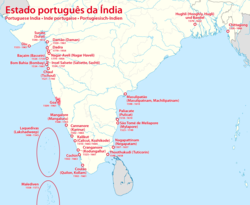This article may require copy editing for grammar, style, cohesion, tone, or spelling. (March 2024) |
State of India Estado da Índia (Portuguese) | |
|---|---|
| 1505–1961 | |
| Anthem: Hymno Patriótico (1808–1826) "Patriotic Anthem" Hino da Carta (1826–1911) "Hymn of the Charter" A Portuguesa (1911–1961) "The Portuguese" | |
 | |
| Status | State of Portugal (1505–1946) Overseas province of Portugal (1946–1961) |
| Capital | |
| Official language | Portuguese |
| Common languages | |
| Religion | Official: Roman Catholicism Major: Hinduism Islam Minor: Zoroastrianism[1][2] Judaism[3] Protestantism |
| Monarch and Head of State | |
• 1505–1521 | Manuel I of Portugal |
• 1958–1961 | Américo Tomás |
| Governor | |
• 1505–1509 | Francisco de Almeida (first) |
• 1958–1961 | Manuel António Vassalo e Silva (last) |
| Historical era | Imperialism |
• Establishment | 15 August 1505 |
| 19 December 1961 | |
| Area | |
• Total | 4,305 km2 (1,662 sq mi) |
| Currency |
|
| Today part of | |
The State of India (Portuguese: Estado da Índia [ɨʃˈtaðu ðɐ ˈĩdiɐ]), also known as the Portuguese State of India (Portuguese: Estado Português da Índia, EPI) or Portuguese India (Portuguese: Índia Portuguesa), was a state of the Portuguese Empire founded six years after the discovery of the sea route to the Indian subcontinent by Vasco da Gama, a subject of the Kingdom of Portugal. The capital of Portuguese India served as the governing centre of a string of military forts and maritime ports scattered along the coasts of the Indian Ocean.
The first viceroy Francisco de Almeida established his base of operations at Fort Manuel in the Malabar region, after the Kingdom of Cochin negotiated to become a protectorate of Portugal in 1505. With the Portuguese conquest of Goa from the Bijapur Sultanate in 1510, Goa became the major anchorage for the Armadas arriving in India. The capital of the viceroyalty was transferred from Cochin to Goa in 1530.[4][5] From 1535, Mumbai (Bombay) was a harbour of Portuguese India, known as Bom Bahia, until it was handed over, through the dowry of Catherine de Braganza to Charles II of England in 1661. The expression "State of India" began regularly appearing in documents in the mid-16th century.[6]
Until the 18th century, the viceroy in Goa had authority over all Portuguese possessions in and around the Indian Ocean, from Southern Africa to Southeast Asia. In 1752, Mozambique got its own separate government; from 1844 on, Portuguese Goa stopped administering Macao, Solor and Timor. Despite this, the viceroy at Goa only controlled limited portions of the Portuguese settlements in the east; some settlements remained informal private affairs, without a captain or câmara (municipal council). By the end of the 18th century, most of these unofficial colonies were abandoned by Portugal, due to heavy competition from European and Indian rivals.[7]
In later years, Portugal's authority was confined to holdings in the Canara, Cambay and Konkan regions along the west coast of India. At the time of the dissolution of the British Raj in 1947, Portuguese India comprised three administrative divisions, sometimes referred to collectively as Goa: Goa which included Anjediva and Damaon, which included the exclaves of Dadra and Nagar Haveli and Dio districts. The Salazar regime of Portugal lost de facto control of Dadra and Nagar Haveli in 1954. Finally, the rest of the overseas territory was lost in December 1961 with the Indian Annexation of Goa under PM Nehru. Portugal only recognised Indian control after the Carnation Revolution and the fall of the Estado Novo regime in a treaty signed on 31 December 1974.[8]
- ^ "Parsi-Zoroastrian Settlement of the Konkan & Thana". www.heritageinstitute.com.
- ^ Shokoohy, Mehrdad (2003). "The Zoroastrian Fire Temple in the Ex-Portuguese Colony of Diu, India". Journal of the Royal Asiatic Society. 13 (1): 1–20. JSTOR 25188328.
- ^ Fischel, Walter J. (1956). "Leading Jews in the Service of Portuguese India". The Jewish Quarterly Review. 47 (1): 37–57. doi:10.2307/1453185. JSTOR 1453185.
- ^ R.S. Whiteway, (1899) Rise of Portuguese Power in India, p.224 Archived 14 July 2023 at the Wayback Machine
- ^ De Souza, Teotonio R. (1990). Goa Through the Ages. Goa University Publications Series No. 6. Vol. 2: An Economic History. New Delhi: Concept Publishing Company. p. 214. ISBN 978-81-7022-259-0. Archived from the original on 14 July 2023. Retrieved 8 May 2022.
- ^ Disney, 2009, p.145
- ^ Disney (13 April 2009). A History of Portugal and the Portuguese Empire, Vol. 2. Cambridge University Press. ISBN 978-0-521-40908-7.
- ^ "Treaty Between the Government of India and the Government of the Republic of Portugal on Recognition of India's Sovereignty over Goa, Daman, Diu, Dadra and Nagar Haveli and Related Matters". www.commonlii.org. 1974. Archived from the original on 3 December 2013. Retrieved 15 April 2020.

